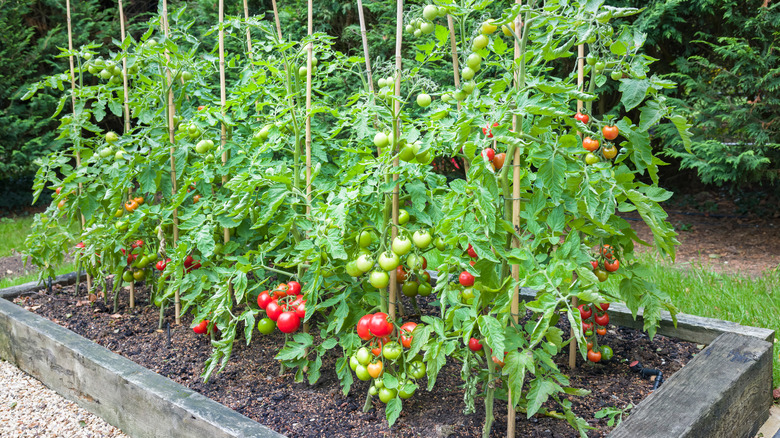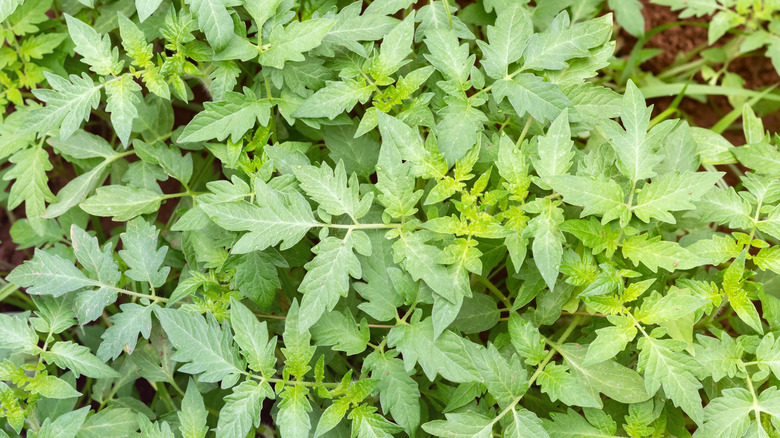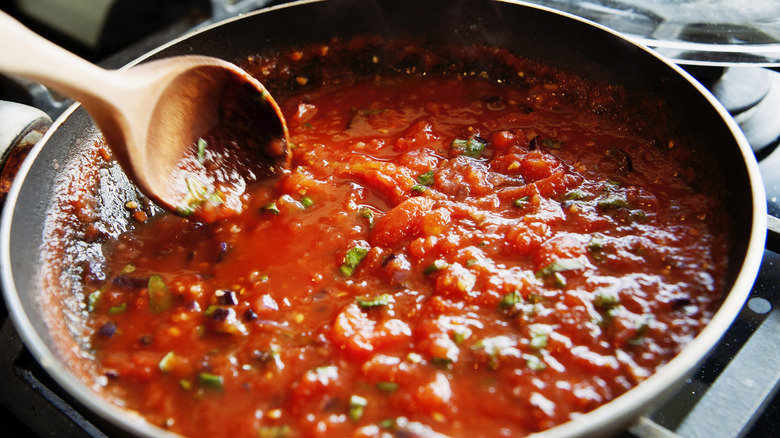Do Tomato Leaves Really Help Boost The Flavor Of Sauce?
Making a good tomato sauce is an essential technique in any cook's repertoire, and there are many ways to layer the flavor. You might start by browning some kind of fatty meat like bacon or pancetta, sautee some garlic and oil, use fresh homegrown tomatoes (or canned San Marzano tomatoes), or even sneak in a parmesan rind for elevated richness and texture.
But what about adding tomato leaves, instead of just the fruit? If you've ever so much as brushed up against a tomato plant, you'll notice that the hairy foliage has an intense, signature aroma somewhat like basil. ScienceDaily explains that this smell partly comes from an enzyme known as 2-hexenal, or "leaf aldehyde," that's common among the tomato's Solanaceae (nightshade) family and many other plant species that exhibit a similarly sweet, grassy fragrance. It makes sense that tomato leaves would taste as strong as they smell. But are they even edible, and if so, what would they do to your pot of spaghetti sauce?
Tomato leaves won't hurt you
Unless you eat a literal ton of them, tomato leaves aren't harmful. According to Gardening Know How, tomatoes have had a (night) shady reputation because they're related to toxic plants like belladonna and deadly nightshade, whose alkaloid Solanine — meant to deter the plant's would-be predators — mostly resides in the plant's stems and leaves. However, Gardening Know How explains that tomatoes instead have tomatine, mainly in the leaves, which is only dangerous in very great amounts, and while some individuals are more susceptible to negative effects from it, these are at most inconvenient and not dangerous. That being said, what would happen if you threw some tomato leaves into the saucepan?
The test kitchen at Cook's Illustrated made two batches of tomato sauce, one with leaves in it and one without the leaves. The taste testers reported that the leafy sauce wasn't as sweet but had a unique flavor and aroma, and the leaf-free version tasted more traditionally tomato-y. Since the alkaloids in the leaves are volatile, they recommend adding them only during the last ten minutes of cooking. Another Cook's Illustrated article explains that you can also let the tomato leaves "steep" in the sauce for about 10 minutes, removing them before serving.
How to cook with tomato leaves
If you want to experiment at home with your own tomato plant trimmings, try ¼ cup of chopped-up leaves for every 8 cups of sauce, and keep the leaves contained with cheesecloth so they don't disperse. You'll definitely want to make sure the leaves are thoroughly washed, as you don't want dirt or leaf-hungry insects winding up in your food, and opt for leaves that haven't been sprayed with chemicals.
So your tomato sauce plot just thickened considerably. WebstaurantStore breaks down several types of red sauce to try with tomato leaves. Marinara is an herbaceous concoction originating amongst Italian fishermen and requires minimal ingredients, while bolognese is a meat-laden sauce with very little tomato. A pasty Pomodoro, AKA "golden apple," is literally named after tomatoes, and arrabbiata sauce is fiery hot due to the addition of red chilis. Of course, there's also pizza sauce, which WebstaurantStore says can be basic tomato sauce, pureed tomatoes, or tomato paste.
But that's not all. Tomato Bible suggests nine uses for the tomato leaf including a mint sauce, hot tea, stew garnishes, tomato leaf pasta, tomato leaf-infused olive oil, and tomato leaf pesto (via Riverford Organic Gardeners). It sounds like what you need to do next is to get yourself some tomato seeds and start planning all the awesome ways you can use the bountiful plants in your next growing season.


